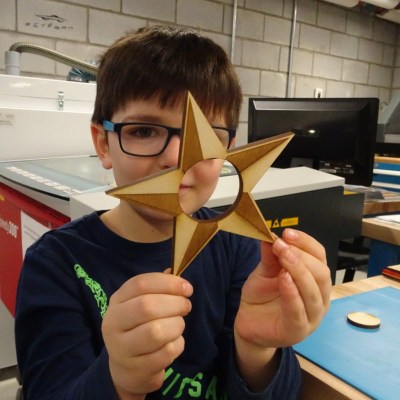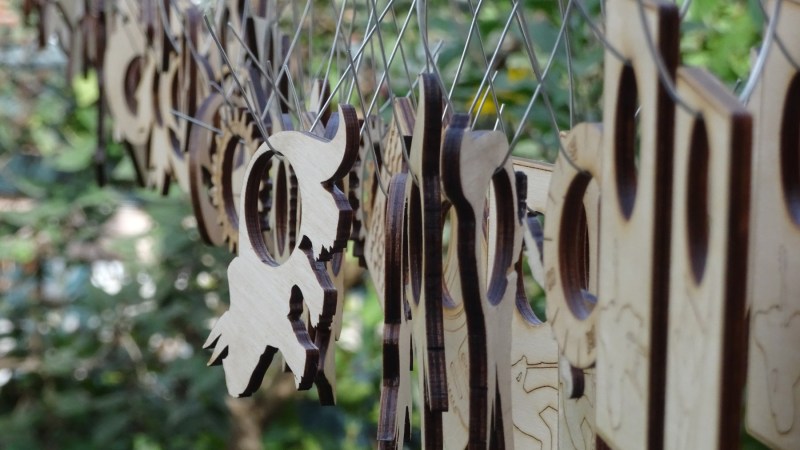Just to be clear, the primary goal of the Papas Inventeurs (Inventor Dads) was to have the kids make something, have fun, and learn. In that light, they enjoyed a huge success. Four children designed, made, and sold laser-cut napkin rings from a booth at the Ottawa Maker Faire as a fun learning process (English translation, original link in French.) [pepelepoisson] documented the entire thing from beginning to end with plenty of photos. Things started at proof of concept, then design brainstorming, prototyping, manufacture, booth design, and finally sales. While adults were involved, every step was done by the kids themselves.
 It all began when the kids were taken to a local fab lab at the École Polytechnique and made some laser-cut napkin holders from plywood for personal use. Later, they decided to design, manufacture, and sell them at the Ottawa Maker Faire. Money for the plywood came from piggy banks, 23 different designs made the cut, and a total of 103 rings were made. A display board and signs made from reclaimed materials rounded out the whole set.
It all began when the kids were taken to a local fab lab at the École Polytechnique and made some laser-cut napkin holders from plywood for personal use. Later, they decided to design, manufacture, and sell them at the Ottawa Maker Faire. Money for the plywood came from piggy banks, 23 different designs made the cut, and a total of 103 rings were made. A display board and signs made from reclaimed materials rounded out the whole set.
In the end, about 20% of people who visited and showed interest made a purchase, and 60 of the 103 pieces were sold for a profit of $126. Of course, the whole process also involved about 100 hours of combined work between the kids and parents and use of a laser cutter, so it’s not exactly a recipe for easy wealth. But it was an incredibly enriching experience, at least figuratively, for everyone involved.
Possibly the biggest takeaway was the way manufacturing involved much more than just pressing “GO” on a laser cutter. Some pieces needed sanding after laser cutting, and each piece got two coats of varnish. If you missed it, [Bob Baddeley] showed how labor, and not materials, ends up being the most expensive part of a product.
















It’s always the labor that gets you. Especially when you don’t have thousands of products to spread it across.
The real lesson is that free child labor can make any endeavor profitable!
Seriously though, I’m sure it was a nice learning experience for everyone involved.
Wish I had access to a laser cutter… all I have is a laser “etcher” built from old DVD burners. Well three old CD ROMs and one burner, the older the drive the better the linear rods.
OTOH, these kids look like they had a great time it’s a makers spin on the old lemonade stand. Never actually a profitable experience but it’s fun for the kids!
You should look into the K40 laser cutters, mine has cost me a total of $400 including extra ducting and modifications like on k40laser.se.
Excluding the extra labour to make it better. :P
That said, that still seems like an amazingly good deal for an inexpensive laser cutter. The school I was at paid something like $4-6k for theirs (from Boss Laser, I think – I don’t know how many watts it was, though).
If you live in a place developed enough that you have internet access then there is probably a makerspace or library somewhere within a couple of hours travel time that you could use if you put the effort into it.
Colfax High School in northern California has a course in their technology program where students build an amplified speaker for a smartphone from a standard design, but they have to develop their own enclosure artwork as well as develop a business plan with a commercial to sell it. Students learn about marketing, costs, determining sales price, product design, etc. I was very impressed with the course as it covered several parts of the overall process of bringing a product to market.